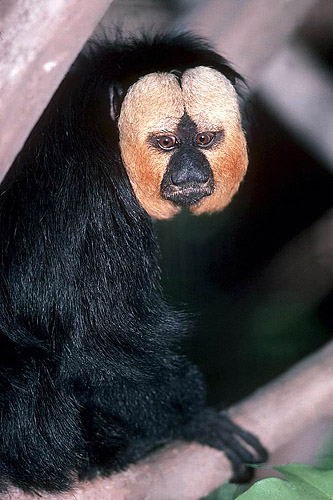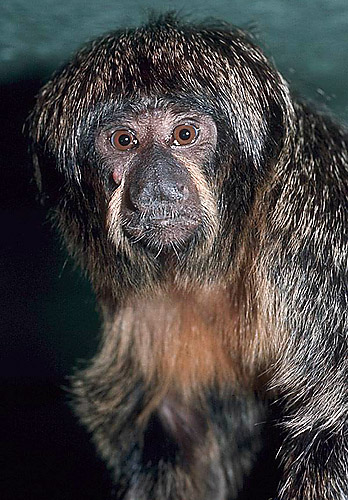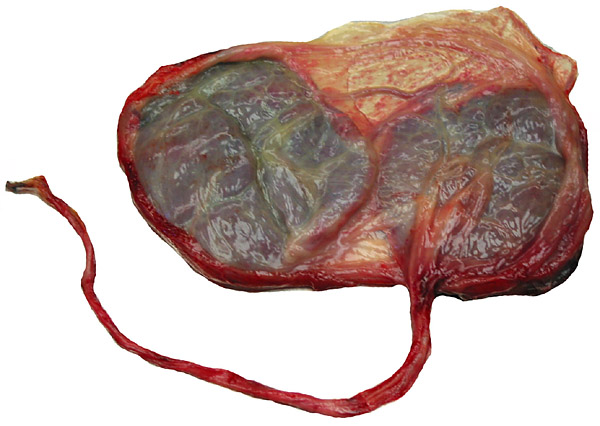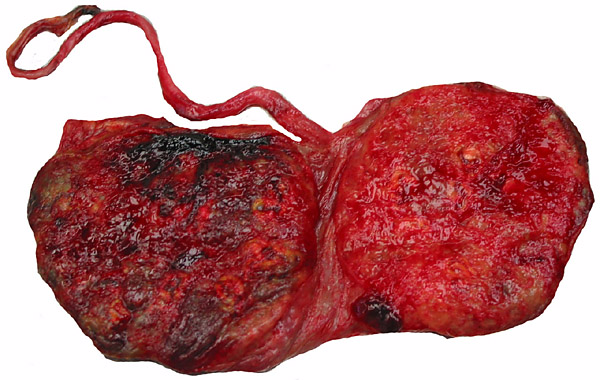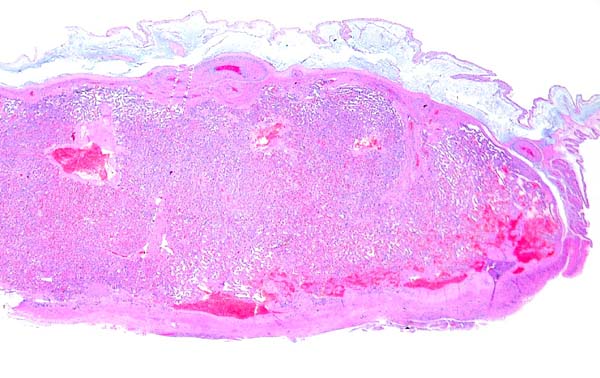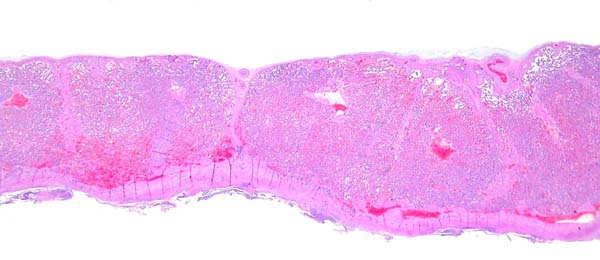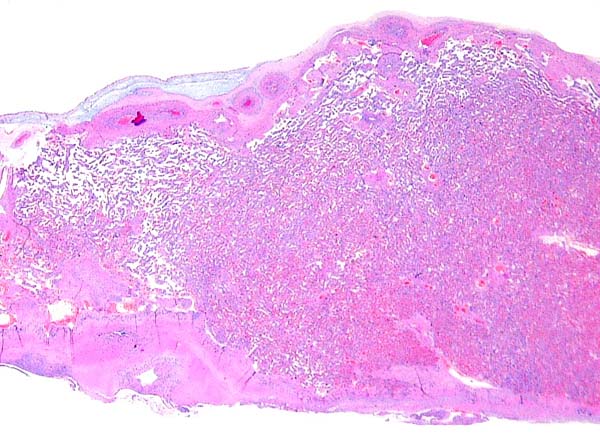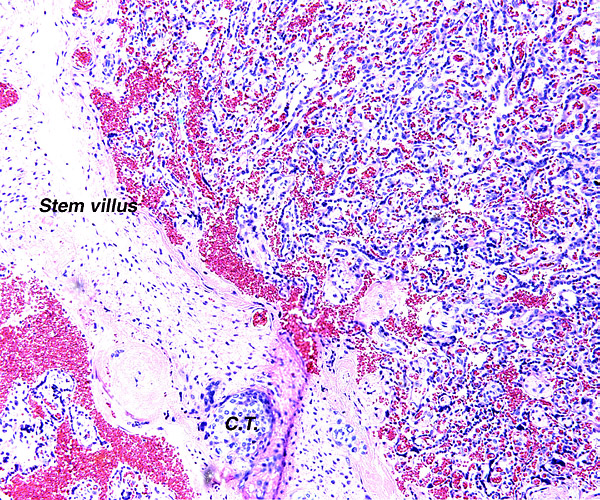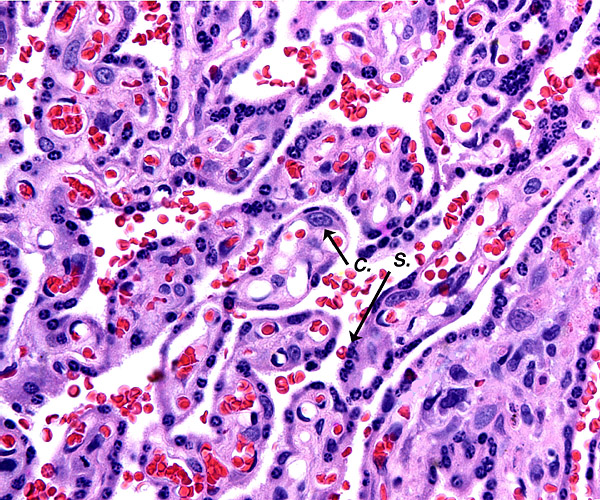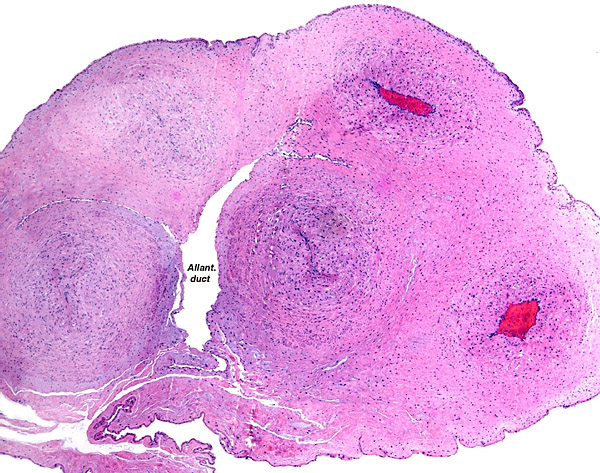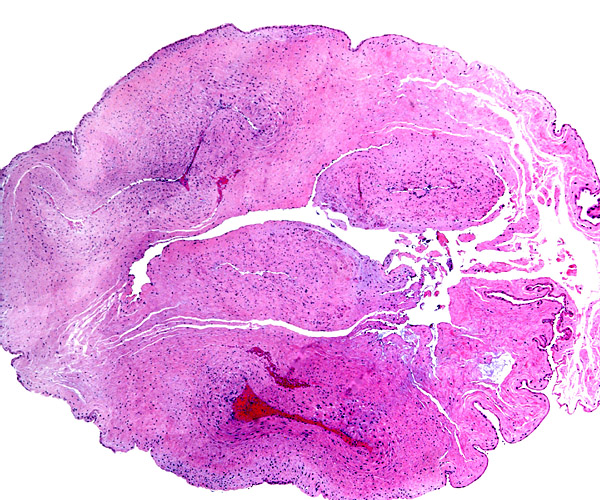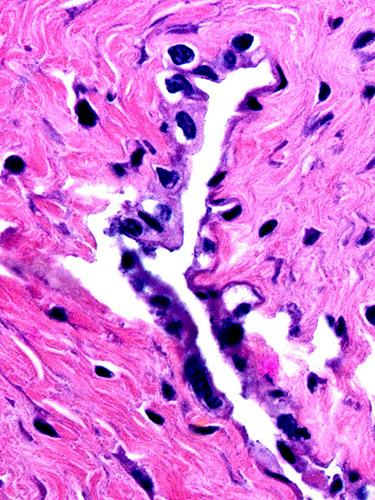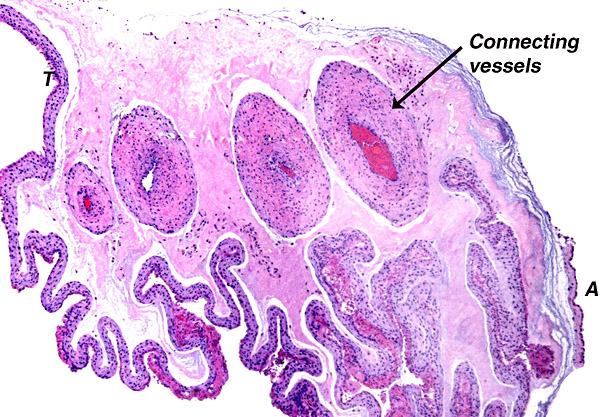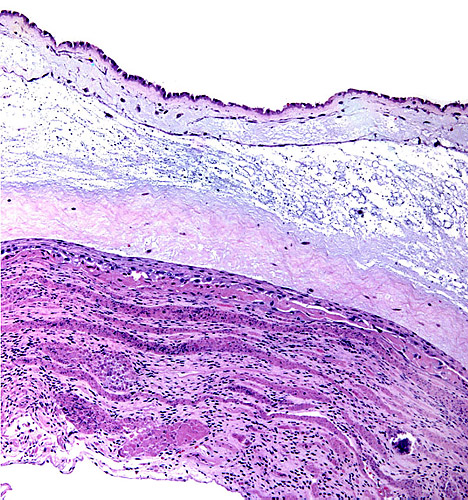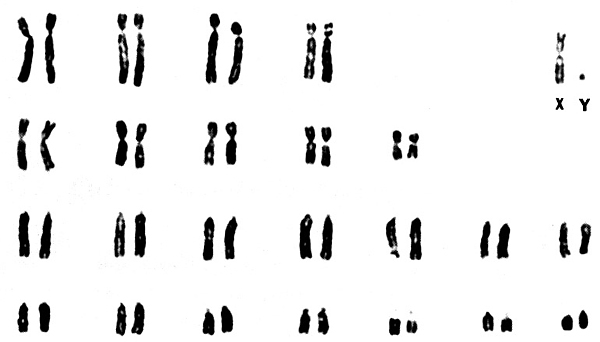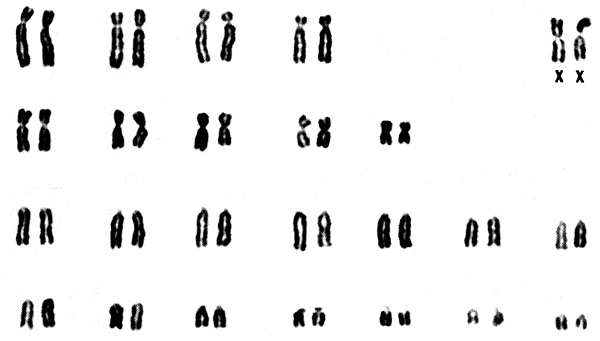14) Immunology
I am not aware of any studies.
15) Pathological features
Scott (1992) depicts extramedullary hematopoiesis in the liver and aspirated squames in the lung of stillborn sakis, both normal findings. Dirofilariasis affected a saki at Dallas Zoo (Gamble et al., 1998). In Florida, a saki developed abdominal lesions that were ultimately diagnosed as being due to Mycobacterium avium lymphadenitis (Heard et al., 1997). Toxoplasmosis was identified in tamarins and sakis by Dietz et al. (1997). Malaria parasites (Plasmodium brasilianum) were found by Fandeur et al. (2000).
A fetal demise of a near-term Northern White-faced Saki fetus (117 g) was due to infection with Yersinia enterocolitica organisms that were also cultured from the fetus. What is remarkable in this case is the fact that villous abscesses were present, in addition to fetal septicemia with small abscesses in lung, liver, adrenal, kidney but that there was no evidence of chorioamnionitis, deciduitis or inflammation in the maternal floor of the placenta. In fact, the most severe inflammatory reaction occurred in the villi of the nearly mature placenta. The mother was asymptomatic and survived another four years during which she had one abortion. Eventually, euthanasia was performed because of terminal renal disease and infestation with Gongylonema parasites. It remains unknown how the organisms entered the fetus without known maternal illness or therapy.
 |
Abscess in villi with dark purple colony of bacteria at right.
|
| |
|
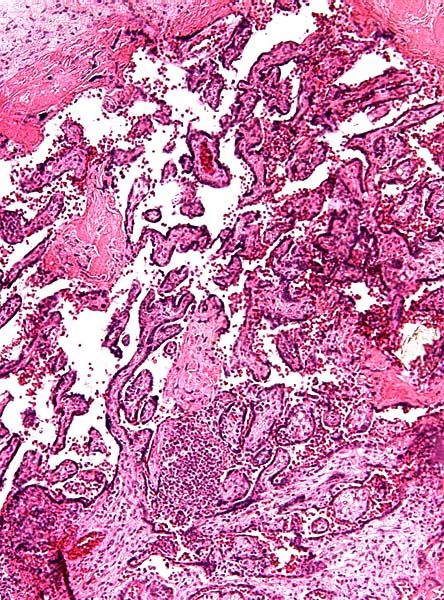 |
Low power view of infected placenta with abscess (bottom center) and normal chorionic plate above.
|
| |
|
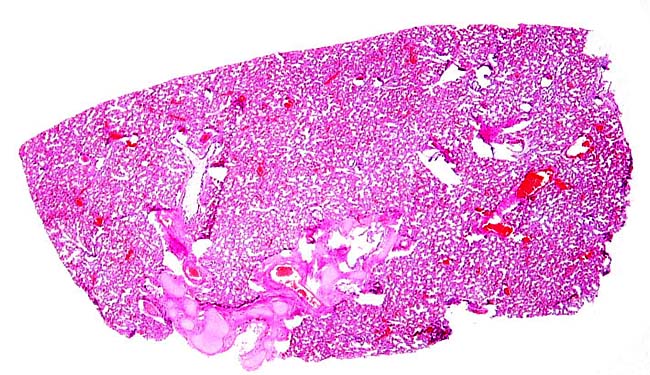 |
Unexpanded lung whose alveoli are filled with amnionic fluid but no bacteria.
|
| |
|
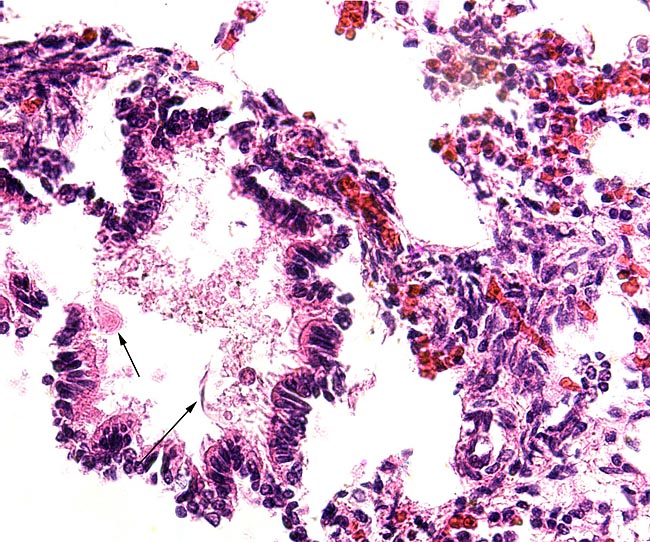 |
Higher magnification of fetal lung with amnionic debris at arrows; no organisms.
|
| |
|
16) Physiologic data
Norconk et al. (2002) examined the transit time of ingesta (seeds etc.) of sakis and the animal's adaptation to much longer transit times than found in other cebid species. Boissinot et al. (1998) found the X-linked color vision system of sakis to differ markedly from other Platyrrhini. The patterns of retinal radiations of platyrrhine species was examined by Kaas et al. (1978). Scent marking was studied by Brumloop et al. (1994). The cellular vitamin D receptors were examined in considerable detail by Gacad & Adams (1991) to explain the differences of vitamin D needs of South American primates.
17) Other resources
Cell strains of this species are available from CRES by contacting Dr. Oliver Ryder at oryder@ucsd.edu.
18) Other remarks - What additional Information is needed?
Early stages of placentation and endocrine studies are needed.
Acknowledgement
The animal photographs in this chapter come from the Zoological Society of San Diego. I appreciate also very much the help of the pathologists at the San Diego Zoo.
References
Alves, G., Seuanez, H.N. Fanning, T.: Alpha satellite DNA in neotropical primates (Platyrrhini). Chromosoma 103:262-267, 1994.
De Boer, L.E.M.: The somatic chromosome complement and the ideogram of Pithecia pithecia pithecia (Linnaeus, 1766). Folia primatol. 23:149-157, 1975.
Boissinot, S., Tan, Y., Shyue, S.K., Schneider, H., Sampaio, I., Neiswanger, K., Hewett-Emmett, D. and Li, W.H.: Origins and antiquity of X-linked triallelic color vision systems in New World monkeys. Proc. Natl. Acad. Sci. USA 95:13749-13754, 1998.
Brumloop, A., Homburg, I., Peetz, A. and Riehl, R.: Gular scent glands in adult female white-faced saki, Pithecia pithecia pithecia, and field observations on scent-marking behaviour. Folia Primatol. 63:212-215, 1994.
Chiu, C.H., Schneider, H., Schneider, M.P., Sampaio, I., Meireles, C., Slighton, J.L., Gumucio, D.L. and Goodman, M.: Reduction of two functional gamma-globin genes to one: an evolutionary trend in New World monkeys (infraorder Platyrrhini). Proc. Natl. Acad. Sci. USA 93:6510-6515, 1996.
Dietz, H.H., Henriksen, P., Bille-Hansen, V. and Henriksen, S.A.: Toxoplasmosis in a colony of New World monkeys. Vet. Parasitol. 68:299-304, 1997.
Eisenberg, J.F.: Mammals of the Neotropics: the Northern Neotropics. University of Chicago Press, 1989.
Fandeur, T., Volney, B., Peneau, C. and de Thoisy, B.: Monkeys of the rainforest in French Guiana are natural reservoirs for P. brasilianum/P. malariae malariae. Parasitology 120:11-21, 2000.
Gacad, M.A. and Adams, J.S.: Endogenous blockade of 1,25-dihydroxyvitamin D-receptor binding in New World primate cells. J. Clin. Inv. 87:996-1001, 1991.
Gamble, K.C., Fried, J.J. and Rubin, G.J.: Presumptive dirofilariasis in a pale-headed saki monkey (Pithecia pithecia). J. Zoo Wildl. Med. 29:50-54, 1998.
Gotch, A.F.: Mammals - Their Latin Names Explained. Blandford Press, Poole, Dorset, 1979.
Gray, A.P.: Mammalian Hybrids. A Check-list with Bibliography. 2nd edition.
Commonwealth Agricultural Bureaux Farnham Royal, Slough, England, 1972.
Harada, M.L., Schneider, H., Schneider, M.P., Sampaio, I., Czelusniak, J. and Goodman, M.: DNA evidence on the phylogenetic systematics of New World monkeys: support for sister-grouping of Cebus and Saimiri from two unlinked nuclear genes. Mol. Phylogenet. Evol. 4:331-349, 1995.
Heard, D.J., Ginn, P.E. and Neuwirth, L.: Mycobacterium avium-intracellulare infection in a white-faced saki (Pithecia pithecia). J. Zoo Wildl. Med. 28:185-188, 1997.
Henderson, A.S., Warburton, D., Megraw-Ripley, S. and Atwood, K.C.: The chromosomal location of rDNA in selected lower primates. Cytogenet. Cell Genet. 19:281-302, 1977.
Hershkovitz, P.: The species of sakis, genus Pithecia (Cebidae, Primates), with notes on sexual dichromatism. Folia Primatol. 31:1-22, 1979.
Hershkovitz, P.: The taxonomy of South American sakis, genus Pithecia (Cebidae, Platyrrhini): a preliminary report and critical review with the description of a new species and a new subspecies. Amer. J. Primatol. 12:387-468, 1987.
Hsu, T.C. and Benirschke, K.: An Atlas of Mammalian Chromosomes. Vol. 10, Folio 515, 1977. Springer-Verlag, New York.
Kaas, J.H., Huerta, M.F., Weber, J.T. and Harting, J.K.: Patterns of retinal terminations and laminar organization of the lateral geniculate nucleus of primates. J. Comp. Neurol. 182:517-553, 1978.
Miller, P.W. and Benirschke, K.: A large allantoic sac in the placenta of the spider
monkey Ateles geoffroyi. Placenta 6:423?426, 1985.
Norconk, M.A., Oftedal, O.T., Power, M.L., Jakubasz, M. and Savage, A.: Amer. J. Primatol. 58:23-34, 2002.
Nowak, R.M.: Walker's Mammals of the World. 6th ed. The Johns Hopkins Press, Baltimore, 1999.
Porter, C.A., Czelusniak, J., Schneider, H., Schneider, M.P., Sampaio, I. and Goodman, M.: Sequences from the 5'flanking region of the epsilon-globin gene support the relationship of Callicebus with the pitheciins. Amer. J. Primatol. 48:69-75, 1999.
Rosenberger, A.L.: Evolution of feeding niches in New World monkeys. Amer. J. Phys. Anthropol. 88:525-562, 1992.
Schneider, H., Cavanez, F.C., Sampaio, I., Moreira, M.A., Tagliaro, C.H. and Seuanez, H.N.: Can molecular data place each neotropical monkey in its own branch? Chromosoma 109:515-523, 2001.
Scott, G.B.D.: Comparative Primate Pathology. Oxford University Press, 1992.
Steiper, M.E. and Ruvolo, M.: New World monkey phylogeny based on X-linked G6PD DNA sequences. Mol. Phylogenet. Evol. 27:121-130, 2003.
|
